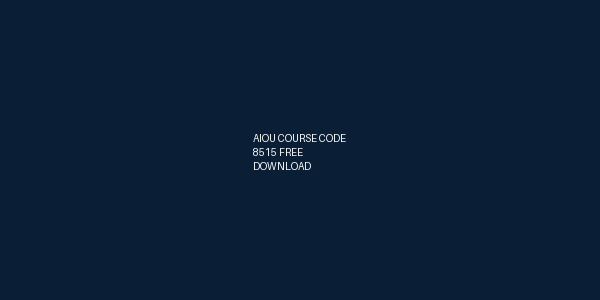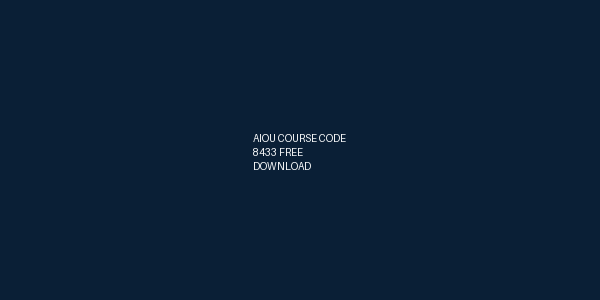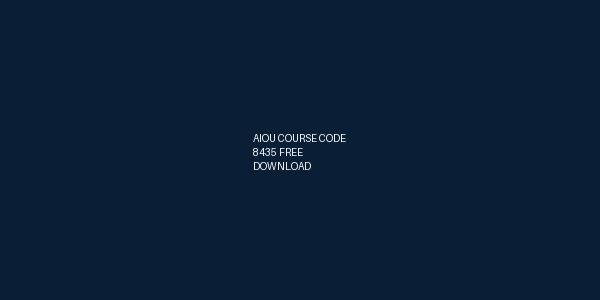AIOU Course Code 8515 Free Download

ALLAMA IQBAL OPEN UNIVERSITY, ISLAMABAD
(Department of Business Administration)
WARNING
- PLAGIARISM OR HIRING OF GHOST WRITER(S) FOR SOLVING THE ASSIGNMENT(S) WILL DEBAR THE STUDENT FROM AWARD OF DEGREE/CERTIFICATE, IF FOUND AT ANY STAGE.
- SUBMITTING ASSIGNMENT(S) BORROWED OR STOLEN FROM OTHER(S) AS ONE’S OWN WILL BE PENALIZED AS DEFINED IN “AIOU PLAGIARISM POLICY”.
Course: Consumer Behaviour (8515/9523/8428) Semester: Spring, 2025
Level: BBA
ASSIGNMENT No. 1
(Units: 1–5)
Total Marks: 100 Pass Marks: 50
- 1 What strategies should a brand adopt to effectively differentiate itself and gain consumer attention when entering a highly competitive and familiar category (e.g., soaps, shampoos, or two-wheelers)? Provide examples to support your approach. (20)
Q. 2 Highlight the key differences in consumer decision-making processes between Fast-Moving Consumer Goods (FMCG) and durable goods. How do these differences impact marketing strategies? (20)
Q. 3 Select a product or service of your choice. Describe how it could be marketed to target consumers by positioning it as both an object of attraction (approach object) and an object of deterrence (avoidance object). Include relevant examples. (20)
Q. 4 Explain the concepts of absolute threshold and differential threshold in consumer perception. Which threshold is more critical for marketers to consider, and why? Provide examples to justify your answer. (20)
Q. 5 What factors influence a consumer’s choice of retail outlet when deciding to purchase a product? Discuss the role of these factors in shaping retail strategies. (20)
ASSIGNMENT No. 2
Total Marks: 100 Pass Marks: 50
This assignment is a research-oriented activity. You are required to obtain information from a business/commercial organization and prepare a report of about 1000 words on the issue allotted to you to be submitted to your teacher for evaluation.
You are required to select one of the following issues according to the last digit of your roll number. For example, if your roll number is P-3427180 then you will select issue # 0 (the last digit): -
List of Topics:
- Cognitive Dissonance Theory
- Attribution Theory
- Communication Process
- Cross Cultural Consumer Behavior
- Reference Groups
- Consumer Decision Making
- Relationship Marketing
- Family Decision Making
- Family Life Cycle
- Consumer Motivation
The report should follow the following format:
- Title page
- Acknowledgements
- An abstract (one-page summary of the paper)
- Table of contents
- Introduction to the issue (brief history & significance of issue assigned)
- Practical study of the organization (for the issue)
- Data collection methods
- SWOT analysis (strengths, weaknesses, opportunities & threats) relevant to the issue assigned
- Conclusion (one-page brief covering important aspects of your report)
- Recommendations (specific recommendations relevant to the issue assigned)
- References (as per APA format)
- Annexes (if any)
GUIDELINES FOR ASSIGNMENT # 2:
- 1.5 line spacing
- Use headers and subheads throughout all sections
- Organization of ideas
- Writing skills (spelling, grammar, punctuation)
- Professionalism (readability and general appearance)
- Do more than repeat the text
- Express a point of view and defend it.
PRESENTATION:
Presentations provide you the opportunity to express your communication skills, knowledge and understanding of concepts learned during practical study assigned in assignment No. 2.
You should use transparencies and any other material for effective presentation. The transparencies are not the presentation, but only a tool; the presentation is the combination of the transparencies and your speech. Workshop presentation transparencies should only be in typed format.
The transparencies should follow the following format:
- Title page
- An abstract (one-page summary of the paper)
- Introduction to the issue (brief history & significance of issue assigned)
- Practical study of the organization (for the issue)
- Data collection methods
- SWOT analysis (strengths, weaknesses, opportunities & threats) relevant to the issue assigned
- Conclusion (one-page brief covering important aspects of your report)
- Recommendations (specific recommendations relevant to the issue assigned)
DETAILED COURSE OUTLINE (8428)
Unit–1: Consumer Behavior and Consumer Research
- Development of Marketing Concepts
- Marketing Concept
- Implementing Marketing Concept
- Segmentation, Targeting and Positioning
- Marketing Mix
- Customer Value, Satisfaction and Retention
- Impact of Digital Technologies on Marketing Strategies
- Consumer Behavior and Decision-Making are Interdisciplinary
- Consumer Research
- Quantitative Research
- Qualitative Research
- Combining Qualitative and Quantitative Research Findings
- Consumer Research Process
- Ethics in Consumer Research
- Development of Marketing Concepts
Unit–2: Consumer Motivation
- Motivation as a Psychological Force
- Needs
- Goals
- Positive and Negative Motivation
- Rational Vs. Emotional Motives
- Dynamics of Motivation
- Types and Systems of Needs
- Hierarchy of Needs
- Evaluation of Need Hierarchy and Marketing Applications
- Measurement of Motives
- Motivational Research
- Evaluation of Motivational Research
- Ethics and Consumer Motivation
- Motivation as a Psychological Force
Unit–3: Personality and Consumer Behavior
- Concept of Personality
- Theories of Personality
- Personality and Understanding Consumer Diversity
- Consumer Innovativeness and Related Personality Traits
- Cognitive Personality Factors
- From Consumer Materialism to Compulsive Consumption
- Consumer Ethnocentrism: Responses to Foreign-Made Products
- Age Discrimination, Sexual Harassment, Disability Discrimination, Religious Discrimination
- Brand Personality
- Self and Self-Image
- Virtual Personality or Self
Unit–4: Consumer Perception and Consumer Learning
- Elements of Perception
- Dynamics of Perception
- Consumer Imagery
- Perceived Risk
- Perception of Risk Varies
- Risk Handling by Consumer
- Ethics and Consumer Perception
- Elements of Consumer Learning
- Behavioral Learning Theories
- Cognitive Learning Theory
- Information Processing
- Involvement Theory
- Measures of Consumer Learning
- Ethics and Consumer Learning
Unit–5: Consumer Attitude Formation and Change
- Concept of Attitude
- Structural Models of Attitudes
- Tri-component Attitude Model
- Multi-attribute Attitude Models
- Theory of Trying to Consume Model
- Attitude Toward the Ad Models
- Attitude Formation
- Strategies of Attitude Change
- Behavior Can Precede or Follow Attitude Formation
- Cognitive Dissonance Theory
- Attribution Theory
Unit–6: Communication, Culture and Consumer Behavior
- Components of Communication
- Communication Process
- Designing Persuasive Communications
- Marketing Communication and Ethics
- Influence of Culture on Consumer Behavior
- Cross-Cultural Consumer Behavior
- Imperative to be Multinational
- Cross-Cultural Consumer Analysis
- Alternative Multinational Strategies: Global Vs. Local
- Cross-Cultural Psychographic Segmentation
Unit–7: Reference Groups and Family Influences
- Friendship Groups
- Shopping Groups
- Work Groups
- Virtual Groups or Communities
- Consumer-Action Groups
Unit–8: Social Class and Consumer Behavior
- Media Exposure of Affluent Consumers
- Segmenting Affluent Market
Unit–9: Consumer Decision Making
- Extensive Problem Solving
- Limited Problem Solving
Recommended Books:
Schiffman, L. G., Kanuk, L. L. (2009). Consumer Behaviour (9th ed.). Delhi: Dowling Kinderslay.
Hoyer., &Macinnis. (2009). Consumer Behavior, (5th ed.). Canada: Nelson Education Ltd.
Khan, M. (2007). Consumer Behavior(2nded.). New Age International.
???

